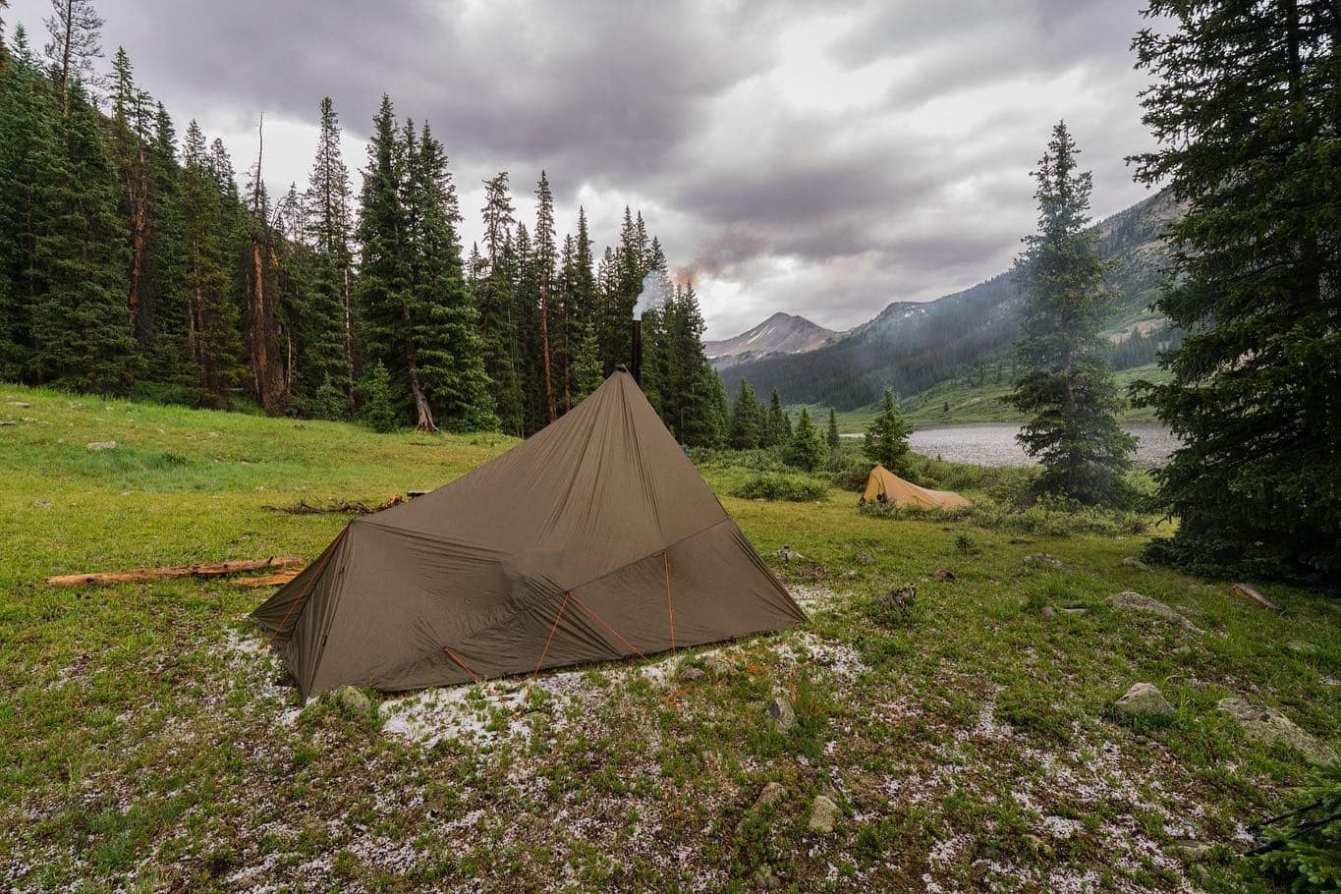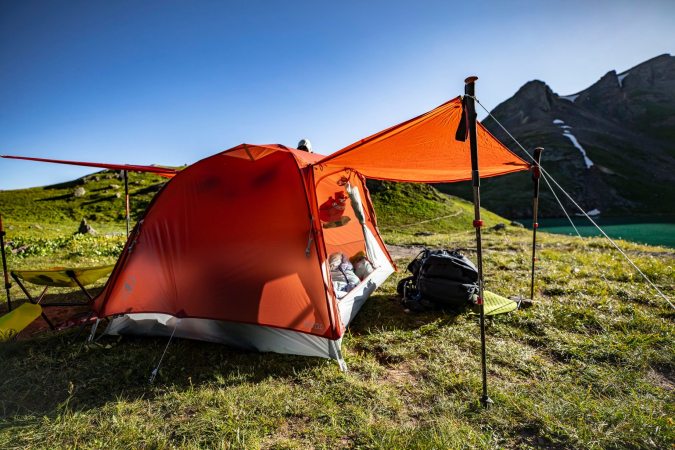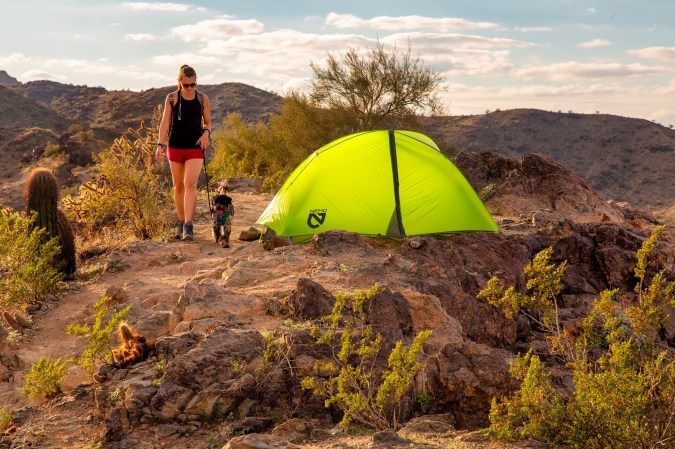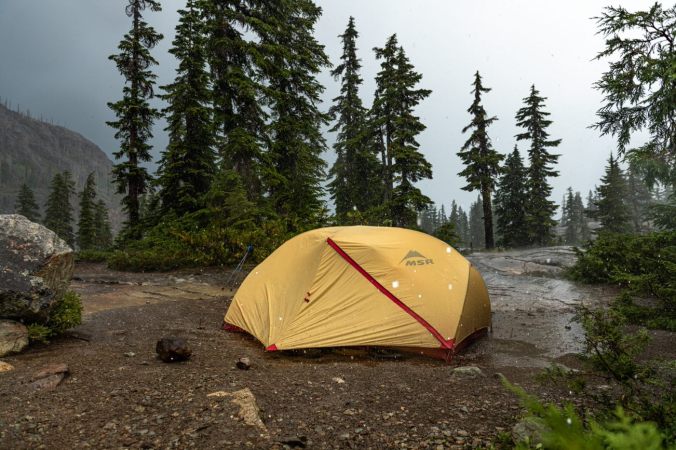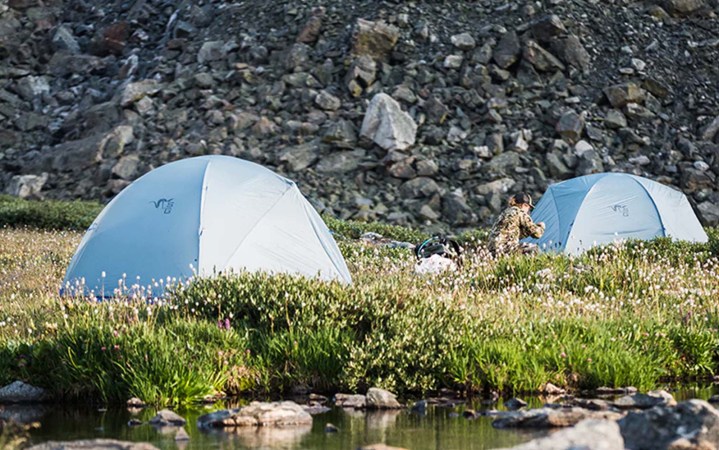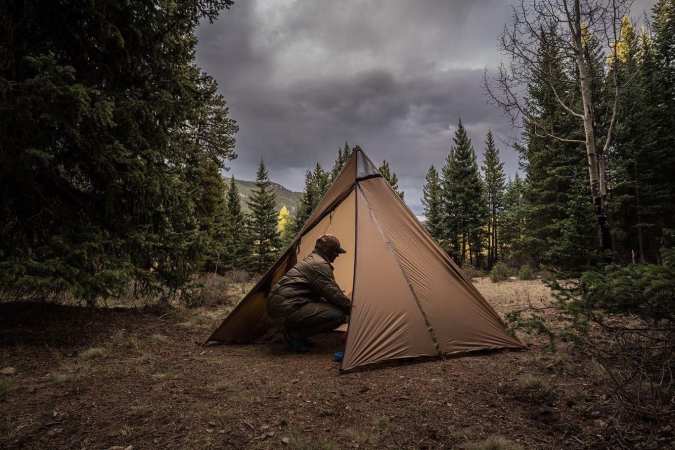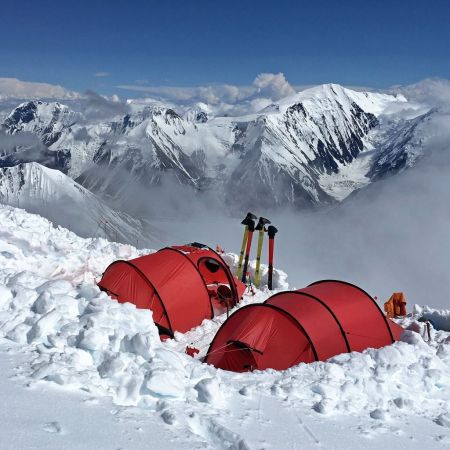We may earn revenue from the products available on this page and participate in affiliate programs. Learn More ›
Tents are a miracle of engineering. With a couple of pounds of nylon and aluminum, you have a wilderness-ready shelter that can withstand just about anything: snow, wind, rain, bugs, and they can even keep out the cold. And it seems as if every year, some of the top tent manufacturers push the envelope even further, finding new ways to cut weight, or create more stability, pushing the limits of what you can do with less. To better understand how the best ten brands bring such innovative and unique products to market year after year, I chatted with the designers and company leaders at Big Agnes, NEMO Equipment, MSR, Stone Glacier, and Kifaru. We’ll be continuing these conversations with more of the best tent brands in the months to come.
Big Agnes
About Big Agnes
Big Agnes is based in Steamboat Springs, Colorado, and has a reputation in the backpacking community for making some of the highest quality (and user friendly) ultralight tents available today. In addition to being a tent brand, they also make sleeping bags and sleeping pads, as well as camp furniture, backpacks, and apparel (I’m a big fan of their Luna/Shovelhead Puffer Jacket and kids’ Icehouse Puffer Jacket). I talked with the company’s owner, Bill Gamber, about how their ultralight lineup came to be and what’s in store for the future.
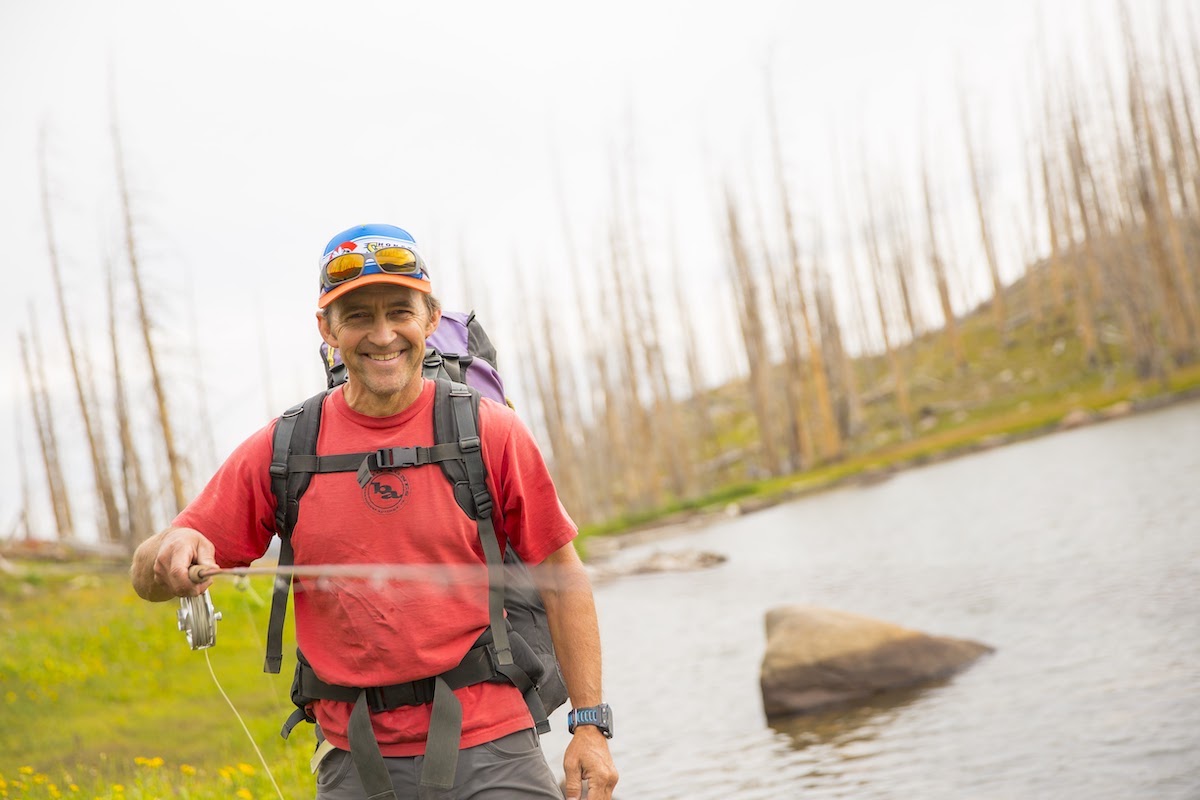
Q: How did Big Agnes first get into making tents?
Gamber: We got into tents almost twenty years ago, after our first year in the sleeping bag market. Bob Swanson, who started Sierra Designs, and, later Walrus Tents, was a good friend of ours and so I asked him what designs that hadn’t worked in the market were his favorite. He had this tent called the Walrus Rapeed XV I, which was essentially a hub design that was just ahead of its time. So we stripped it down, using new fabrics and materials with his general architecture to make it lighter and more marketable. The first year we just made the Seedhouse and the Mad House. And then we developed the Seedhouse SL, which was even lighter, and that’s what really stuck. We thought the Seedhouse SL would be for the weird niche guys that were cutting off their toothbrushes, but we touched the nerve of more traditional backpackers as well—they were like, “Wow, I can take a pound and a half or two pounds off of a tent and it’s as weatherproof or more?” Now we look back on it, and we completely changed the direction of how people design tents.
Q: How do you approach designing a new tent?
Gamber: Even though we were the first company to produce a four-pound, freestanding backpacking tent, we kept challenging ourselves to go even lighter. Along the way, we’ve had to balance that with the market’s expectation that a tent will be dependable, and durable, although we know that the crazy ultralighters can be very particular and careful, with carbon fiber poles with Dyneema fabric. When we were really striving to break barriers, we would essentially take scissors and cut things off to learn more about the construction of a tent—even today, some of our competitors don’t understand what we’ve done to shave ounces. We also have an incredible fabric partner that gives strong, lightweight fabrics that our competitors don’t really have access to.
Q: How does Big Agnes ensure the quality of its tents for consumers?
Gamber: The secret sauce to Big Agnes is that we all use our products. We’re fortunate enough to be in Steamboat Springs; I look out my window and the Yampa River is right here. Since access to the outdoors is literally out our office door, we’ll have these company campouts where we’ll drive to a trailhead at the base of Big Agnes and hike up to 10,000 feet. We camp at Mica Lake and then in the morning, hike up to the top of Big Agnes. Then we’ll hike down and be back at work by noon the next day. And people are on the clock, getting paid to go camp. We have this group of people that are true outdoor enthusiasts—everybody from our accounting team to marketing to customer service—so when we have a new sample, someone can go and use it that day and give us feedback by tomorrow. And they’re the biggest critics you can find, more so than our customers sometimes. If it passes the test with our team, then we know it can go the mileage.
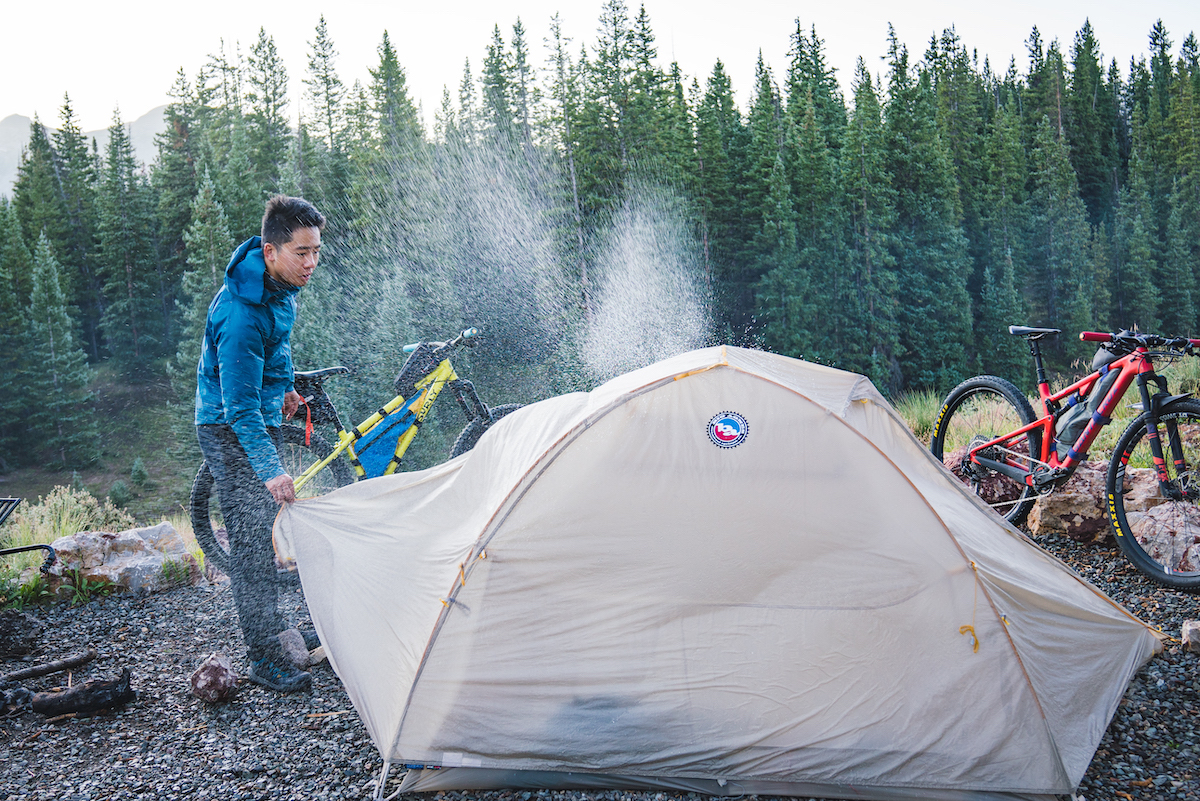
Q: What do you think gets overlooked in the outdoor industry?
Gamber: As an industry, we need to make more sustainable products, and we need to pressure and challenge each other to be better. For Big Agnes, many of our manufacturing partners have at least some solar electricity at this point, and our solution-dyed fabrics, which we use in the Tiger Wall UL and Fly Creek HV UL tents, mean that we’re not dying those fabrics, and dying is not a clean business, after they come off the loom. We also educate people to leave no trace. That sounds so cliche, but we really mean it, and we live it. We are responsible for seventy miles of the Continental Divide Trail that’s just out of town, and we keep that section of the trail in really great shape. And then, since COVID hit, so many people are coming to Steamboat Springs to camp—and when every single camp area that they see is taken, they might just camp in a meadow. And then the next person sees some tracks there. And then, by the following weekend, there is a camp ring or fire. And so we’ve partnered with the Forest Service to see how we can help clean some of those, and close those areas off with signs. We feel that we benefit by growing the outdoor industry and getting people outside, but we’re also responsible to help protect the outdoors.
Q: What’s your most popular tent?
Gamber: The Copper Spur collection is definitely our most popular series of tents, because of its weight-to-size ratio.
Q: What’s your favorite tent, personally?
Gamber: I’m kind of notorious for forgetting to bring a headlamp, so my favorite tent is the Copper SpurHV UL mtnGLO, which has LED lights wired into the tent structure itself.
NEMO Equipment
NEMO Equipment, based in Dover, New Hampshire, is known for their unique and innovative approach to the technical design of outdoor gear. In addition to making tents, they also make some of the best sleeping bags, sleeping pads, furniture, and accessories. While talking with the company’s founder and CEO, Cam Bresinger, I learned more about how they design their unique lineup and how they’re tackling their carbon footprint.
Q: How did NEMO Equipment first get into making tents?
Bresinger: I went to the liberal arts Middlebury College in Vermont, where I studied creative writing, physics, and studio art. After graduation, my only concrete plan was to climb Denali, which I did with a few friends. After that, I started traveling around, trying to sort out what I was going to do for a career. Looking for a way to merge my interests and my educational background, I ended up going back to the Rhode Island School of Design for industrial design. I spent the next three and a half years focused on starting the brand, including pondering what my opening product line should be. Eventually, I decided that tents would be a pretty cool place to start. First off, they’re our home in the wilderness and so have some metaphorical significance. I also thought that if we figured out how to do tents, because they incorporate both engineering and design, that our skills and our supply chain would be transferable to other categories. We ended up launching NEMO around low-pressure, inflatable tents—air-supported tents, we called them—which was really different for the outdoor industry at the time, although we also made some more ordinary pole tents because we didn’t want to start being called “the inflatable tent company.”
Q: How do you approach designing a new tent?
Bresinger: Since I was working on the first products at the same time that I was learning design in school, I was getting to see a lot of other people’s processes and benefitting and learning from the critiques of my classmates. So that’s where the NEMO design philosophy originated from, the creation of a rich and iterative process. In other words, if you asked me to design something, start to finish, just with pencil and paper, I’m going to be limited. But if I can fold in other tools, like using CAD and going into the shop and building scale models and prototypes, it creates this richness. What we’ve found is that it’s important to not get so wedded to any idea that you become blinded to other possibilities. We try to treat every design as just an iteration, without trying to move too fast through it.
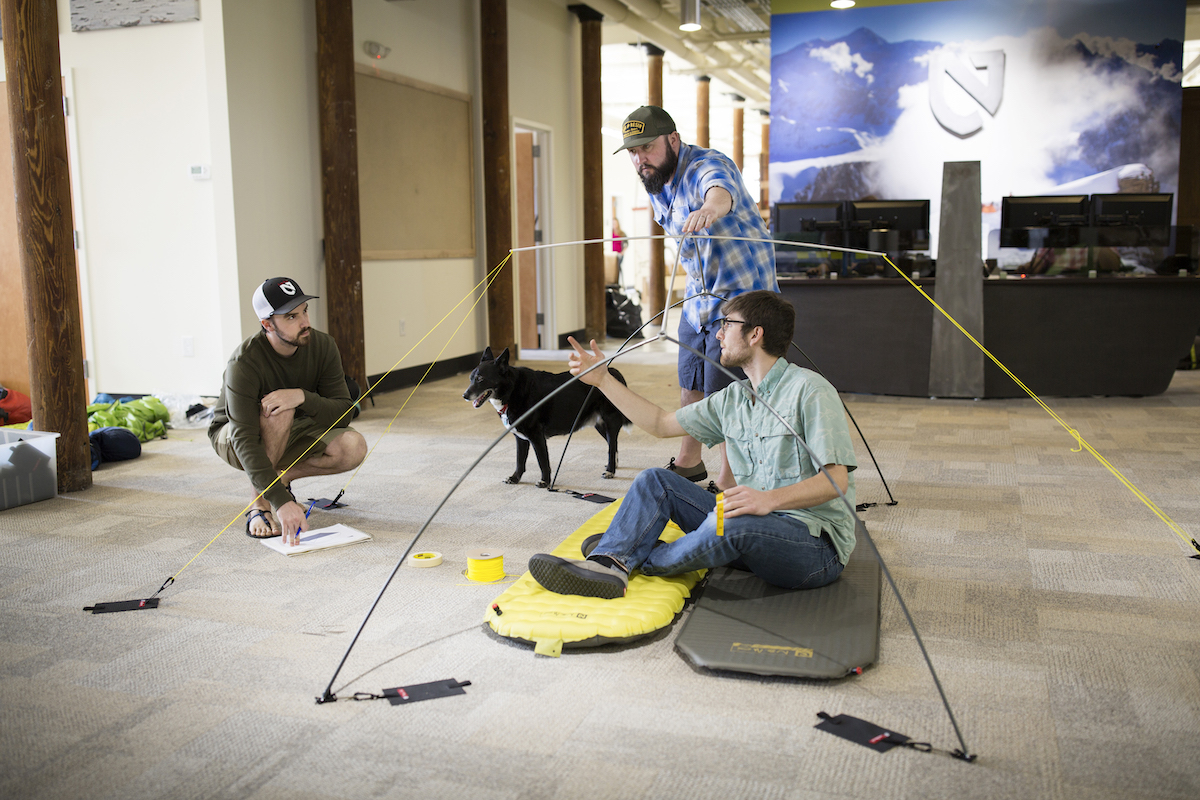
Even today, in our really nice office with our test lab and shop and the tools that we’ve acquired over twenty years, we still end up using a lot of cardboard and duct tape and painter’s tape. We love to use painter’s tape on the floor, then bending poles into shapes, so that you have something full scale you can walk around, you can sit in, you can put your sleeping pad and sleeping bag in. That’s something that started in school and we’ve continued to evolve that process over the years.
At the root of all that, though, is a commitment on our part to never bringing anything to market that’s the same as what’s out there. Our design process is about arriving at things that we think bring real value to the end user.
Q: How does NEMO Equipment ensure the quality of its tents for consumers?
Bresinger: In the early days of NEMO, I relied heavily, too heavily, on my own experience and judgment as to whether a product was performing at a high level. Partly that was because our access to tools and partners and outside resources was limited, as was our supply chain and buying power. We had to choose off-the-shelf fabrics and hardware. But at the same time, we recognized that if we screwed up and brought a less than high-quality product to market that it could permanently damage the reputation we were trying to build. So something we did early on was build ourselves a rain chamber, because our tent development cycle would end in the winter, and we couldn’t really take our tents out and test how they would do in a thunderstorm in January.
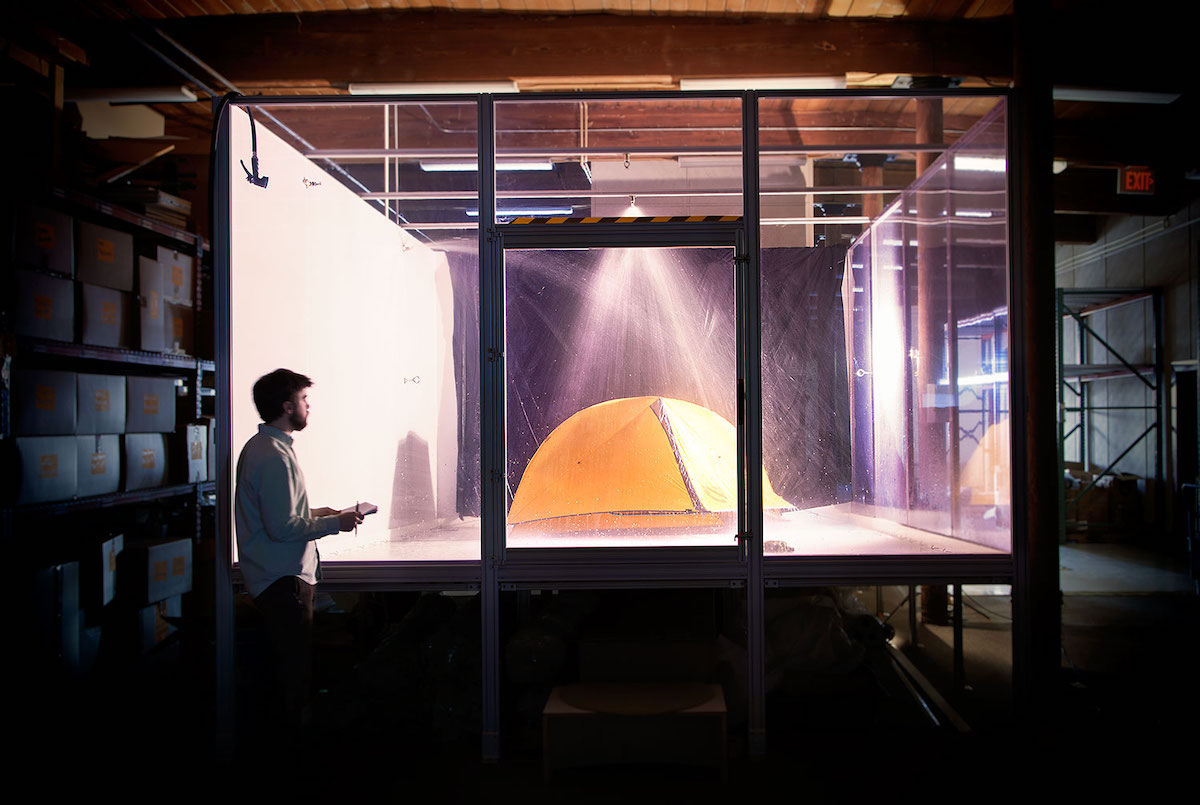
Today, we have an extensive lab in our own facility with a much more sophisticated rain chamber and a whole lot of testing equipment, both physical testing for things like furniture, and also testing for fabric performance and waterproofness. We also contract and work with our NEMO ambassadors for field testing. Finally, we work with a global test agency that supports our factories around the world and ensures that quality control is happening. So now there’s a whole team of people who bring different skill sets and experiences, so it’s not just me making most of the product decisions anymore.
Q: What do you think gets overlooked in the outdoor industry?
Bresinger: You know, if anything is entirely overlooked, and I hope there’s nothing major, then I’m probably part of that. There are certainly areas that are underserved. The first is that our industry has a history of being very exclusive. It’s largely been a white industry, available to those with spare money and spare time for backpacking, camping, mountaineering, hunting, fishing, etc. It’s been something, by and large, that you needed a certain amount of privilege to enjoy. I think I speak for much of the collective outdoor recreation industry when I say that the last few years of the pandemic opened our eyes to just how vital the outdoors is to all of our health, and that this is something that should be available to everyone. This is something we think a lot about as a high-end brand, where our requirements for quality and performance mean that our products are expensive. We want those products to be available to more folks. One of the ways that we’re addressing that is setting up the infrastructure for re-commerce. So rather than making things “cheaper,” we can make previously used equipment available at more accessible prices.
Another area that I think we haven’t addressed enough is our impact on the climate. For me, the challenge is to figure out how to reverse climate change without expecting major sacrifices out of our customers and without adding a ton of cost. The ultimate sustainability challenge for NEMO is really to reinvent the materials, the processes, and the supply chains. Right before the pandemic, our product team drafted an internal memo that asked what it would look like to make a really, truly, sustainable product. We ended up deciding that it meant fully addressing that product’s carbon footprint, including leaving no waste in the factory and addressing its end of life, so it would need to be both recyclable and recommercable. We’re launching our first product in this program, called “Endless Promise,” next year. It’s our Forte sleeping bag, which is one of our most popular products. It actually takes all of the waste it produces in the factory and reprocesses it into insulation, which we then feed into the bag. We also wanted to make the product recyclable, which turned out to be the most difficult part of this. It’s not hard to work with your factories and sourcing people to find recycled materials to substitute in for virgin materials, but making a product like a sleeping bag recyclable is a whole different story. It means making the entire product out of a single polymer and then finding a recycling partner who’s capable of handling that. We’re doing both of those things with the Forte.
Q: What is your most popular tent?
Bresinger: Our core backpacking tents, the Dagger and Hornet, are very popular, and we’ve continued to optimize them bit by bit over the years.
Q: What is your personal favorite tent?
Bresinger: The Aurora Highrise, since, these days, I’m usually in a larger camping tent with my wife and two kids.
Mountain Safety Research
Mountain Safety Research, based in Seattle, Washington, has been at the forefront of mountaineering gear for decades. In addition to being one of the best tent brands, MSR also make some of the best backpacking stoves, snowshoes, and water purifiers, including for the US military and NGOs. I got a chance to talk to their newest tent designer, Katie Nash, to learn more about what’s next for this storied brand.
Q: How did MSR first get into making tents?
Nash: When MSR was founded in 1969, they had a few mountaineering tents that were using the first generation of waterproof breathable fabrics. They ended up moving away from mountaineering tents to focus on stoves and water filtration, but then, around 2000, MSR recognized that there needed to be more high-quality lightweight backpacking tents and mountaineering tents on the market. Inspired by the design and features of the tents from Walrus and Moss, which were folded into MSR, they launched the Hubba Hubba in 2002. That tent was groundbreaking for shedding pounds while still providing a livable interior space for two.
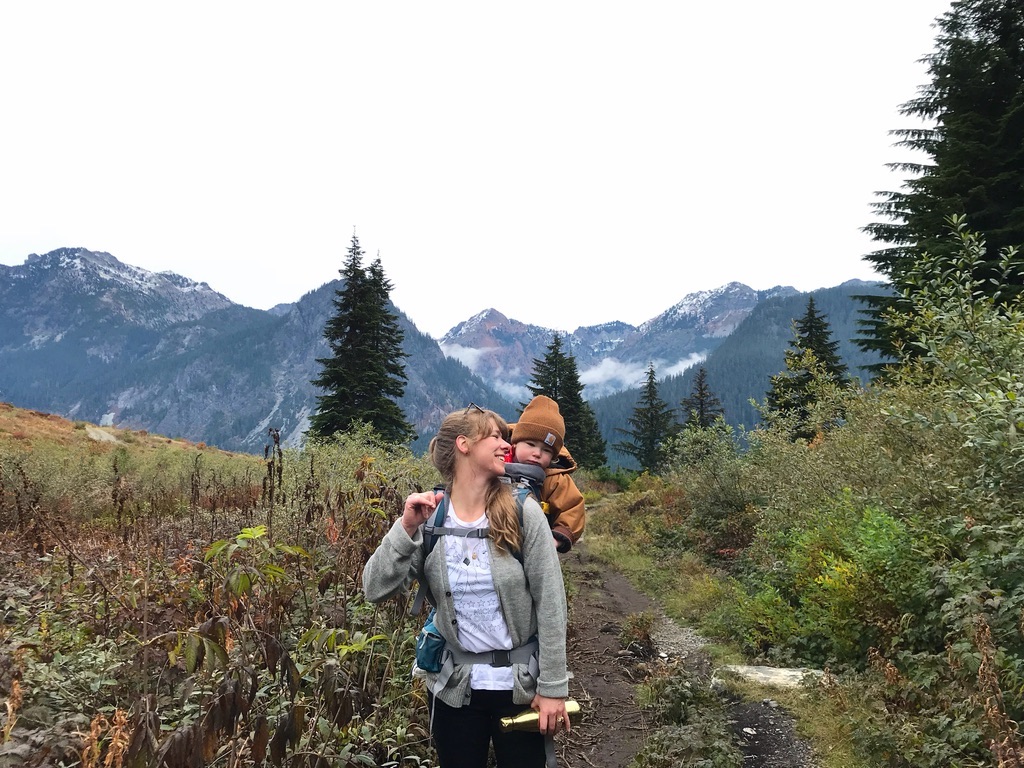
My background is as a designer—I actually went to school for art and apparel. But I really didn’t want to work in fashion, so it was lucky that I got some contract work at Cascade Designs [the parent company of MSR] ten years ago. From the start, I was always really nosy around the tents, inserting myself into the conversation whenever I could. I just thought they were such a cool product. It is architecture, and it is light, and it is a packable home. Tents just appealed to me in so many different ways. So after working on the sleeping bag and soft goods side, I recently stepped into the tent design role at MSR.
Q: How do you approach designing a new tent?
Nash: MSR was founded by engineers, and I feel that I’ve taken an oath to apply that methodology to our tents. It starts by defining a problem and the customer. Next, we ask questions about the customer and imagine solutions to their problem. And then, we start on a prototype.
While some tent designers approach their work by partnering closely with manufacturers, and others focus heavily on the structural design, MSR combines these two approaches. It’s a lot of iteration, looking at samples with other people, going out into the wild to figure out the failure points, and then another iteration. If we need a new hub, or something like that, then we can ask one of our engineers to design it for us. We also have a pretty cool test lab at Cascade Designs that we can rely on to test the durability and strength of fabrics and other components. It takes a village to raise a tent.
I think of myself as an outsider, since I didn’t grow up backpacking, or skiing, or anything like that, As a designer, I try to empathize with the customer and approach their problem with a lot of questions and curiosity to arrive at equally good, but perhaps different, solutions than a designer would who had grown up around those activities.
Q: How does MSR ensure the quality of their tents for consumers?
Nash: We have our in-house repairs and warranty team that we work with whenever we’re hearing from customers that there’s a weird or repeated failure—then you have to scramble and fix that ASAP. With tents, something that comes up a lot during the design process itself is fabric coating and seam tape technology, where the goal is to get the best coating that lasts the longest. So we use our lab to run a series of tests for humid aging, where the fabrics are basically put into this oven, and then you take the fabric out every so often to check things like the hydrostatic head, to see if it’s still waterproof, or you would check for visual decay. Sometimes it can be the case that something looks bad, which is disconcerting for the customer, but it might actually perform well enough. That said, we want to inspire confidence in the customer, given our commitment to delivering the most durable high-quality fabrics and coatings and other components that we can possibly afford.
Field testing is also really important, for all of our products. We can always find volunteers in our office—basically half the company is willing to do field testing—to take a day off and go, say snowshoeing, so it’s pretty easy to get our tents in the hands of people to test in the wild. We also have people outside of the company who do field testing, answering our questions on our surveys.
Q: What do you think gets overlooked in the outdoor industry?
Nash: There is a whole range of diverse needs and interests out there. So while MSR has a brand identity, and we want to focus on what we do best, our products don’t always have to be purely based on traditional ableist or achievement-based Type 2 fun. All kinds of people are enjoying and experiencing the outdoors, and everyone should be welcome—it doesn’t just have to be the people who are summiting mountains. We know that the frontcountry camping part of the industry is way bigger than the summiting Everest part of the industry—even if products for the latter crowd are really fun to make. But I think we as an industry are starting to realize that it’s not just about us—there’s so many different kinds of people, and we need to address their needs better. MSR has been very focused on safety research, but I think we can do that and work more on products for the frontcountry, like we’re doing with our Habitude tents.
On more of a personal level, I think we have pushed manmade materials to some really incredible places, performance-wise, but I wonder if it’s time to start looking back toward more bio-based materials again. I wouldn’t claim that a cotton tent is going to be the thing that you should bring on a thru-hike, but I think we could bring the ancient materials that evolved over the course of millions of years back into our lives. We’ve been so excited about the performance of some of these synthetic materials, but what research could we do on plant-based materials, and how could we pull them more into our outdoor recreating?
Q: What is your most popular tent?
Nash: The Hubba Hubba is the most popular tent that MSR makes.
Q: What is your personal favorite tent?
Nash: For me, the lighter the better, so I really like the Freelite, especially the new one that just came out.
Stone Glacier
Stone Glacier, based in Bozeman, Montana, was founded with the intent to build the lightest and most durable gear for hunters in the backcountry. In addition to making tents, they also make backpacks, apparel, sleeping bags, and sleeping quilts. Stone Glacier’s founder and lead designer, Kurt Racicot, spoke with me on the phone to share more about how they approach creating products to meet their customers’ needs.
Q: How did Stone Glacier first get into making tents?
Racicot: So we first came out with backpacks when I started the company in 2012. As we grew, we started to look at other pieces of a hunter’s kit, and we had ideas for how to improve apparel and tents. We approached tents with a backpacks hunter’s mindset—we knew our list of factors needed to include a high-elevation, four-season-type tent, with adequate vestibules. And we just continued down that path.
There were several designs I was working on for our first tent, so I connected with a friend, Martin Zemitis, who has been designing high-elevation, mountaineering-style tents for the outdoor community for years. We knew that it was hard to duplicate thirty-five years in the business, so we partnered with him on some design features for the final product. Martin has some patented technology, including the WebTruss, which is a unique feature that helps with wind stability and snow load and really plays into its performance in four-season situations. It was also important to us, because we are a backpack hunting company, that it be a lightweight tent, under five pounds for a two-person tent. Those were our two main goals. And then, from there, we were able to branch out a little to say OK, how can we make it more comfortable for two people? Well, if you have two vestibules, then you have enough room for two people’s gear, so having two doors would be nice. So we started adding and subtracting features to fit within what we were trying to do. The two-person Skyscraper was the first tent that we came out with.
Q: How do you approach designing a new tent?
Racicot: With all of our products, we definitely start with the situation. Where’s it going to be set up? What conditions will it be used in? How many people are going to be in it? For example, if we were designing gear that was primarily going to be used in July and August, we’d be able to get away with lighter-weight tech, like a mesh insert, but those aren’t the conditions that our customers will be facing. A lot of times our gear is used in Alaska, in the Brooks Range, the Yukon Territory, or British Columbia—places that get very substantial weather. So our tents have to be able to keep moisture out, even in the driving rain.
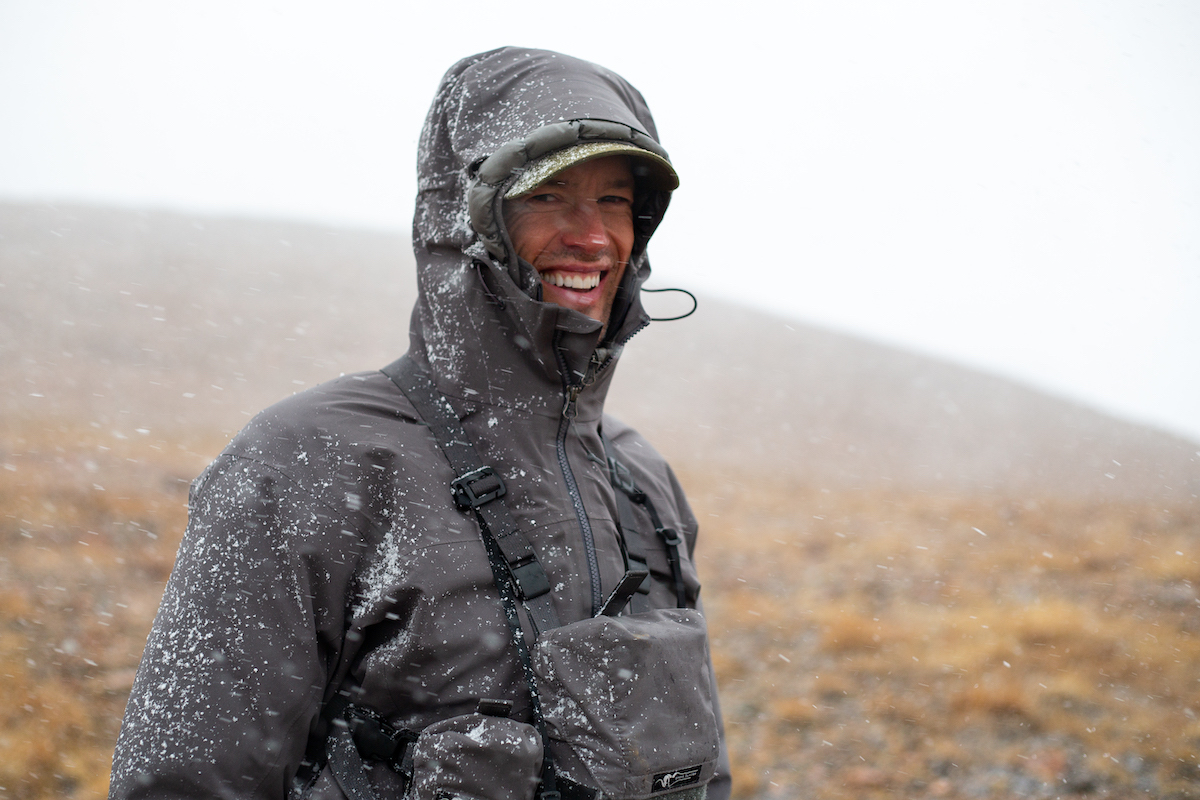
Then we work from there to say, OK, how is this tent actually going to be used? Is it going to be taken down and set up every day? Is it going to be packed over long distances? If you’re in a mobile hunting application, much like you would be if you were thru-hiking or on a long trek where, even if it’s drizzling rain all night, you can’t just lay in your tent in the morning until everything dries out and then start again. You have to get up, and you get your stuff packed. So it’s important to be able to separate the fly body from the fly sheet that might be wet—otherwise, you’re gonna be sleeping in a wet tent the next night. So those intricacies of how it’s being used come into play with the design features. Another big focus in our design philosophy is producing the lightest weight gear that can do these things, so that you can cover more ground with less weight. If you’re trying to move five or seven miles every day and set your tent up quickly and take it down quickly and manage moisture and still have room for two people and your gear, then you really have to take everything into account.
Q: How does Stone Glacier ensure the quality of its tents for consumers?
Racicot: For the majority of our products, I do the patterning, I do the sewing, and then I take it out and test it. Then I come back and tear it apart and resew it, and then go out and do the same thing again. It really speeds up the whole process when you’re not sending it to a factory every time. The person who is designing the tents is also testing the tents, so we can go through a sample very, very rapidly and very thoroughly. Even though we were working with another designer, the process for our tents was the same. I could still take it apart and put it back together while we were going back and forth. This really speeds up how quickly we can bring products to market and how quickly we can actually field test and verify the design, materials, and sewing features are going to hold up.
Q: What do you think gets overlooked in the outdoor industry?
Racicot: I would say one of the things that gets overlooked is customer feedback, and customer service. With social media, people can get an opinion out there as soon as something comes into their mind, and it’s published before they’ve even really thought about it sometimes. But there is also a lot of good feedback in the social media realm. It can be time consuming to dig it out, to search out those people and get more information. But we’ve found it’s important to sit back and be open minded and humble about our designs, to be able to hear critiques and converse with those people to see what their feelings are and consider whether we should improve a product or change something.
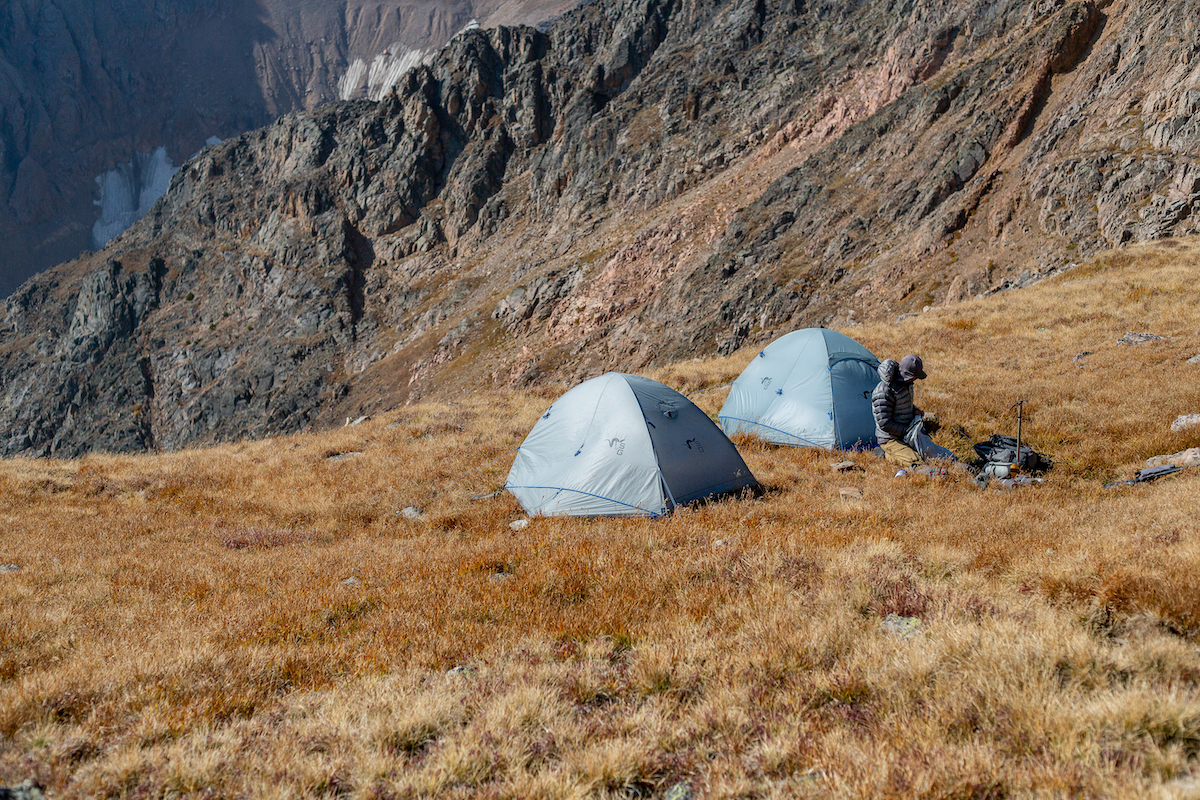
One of the big reasons this can be overlooked is that it’s a lot of work for a designer. If I was a wholesaler and I sold a product that somebody didn’t like, I just wouldn’t carry it anymore. I wouldn’t take it personally. It’s hard from a designer’s standpoint, to spend a lot of time to make something and really think you have it done, and then to hear that it’s not that great or that there’s something wrong with it. Maybe you see where they’re coming from, maybe you gather more information and see if there’s a better way to do things, such as better educate the customer.
Q: What is your most popular tent?
Racicot: So our most popular tent is our two-person Skyscraper. It’s also our most versatile tent, with a minimum trail weight of four pounds, three ounces—that’s under two and a half pounds per person for a four-season sleep system.
Q: What is your personal favorite tent?
Racicot: My personal favorite is actually one we are coming out with this fall, the Solus. It’s a one-person, freestanding, four-season tent that will fit someone up to six foot four, very much along the lines of our Skyscraper two-person tent. Last fall, I probably had thirty-seven nights in it.
Kifaru
Kifaru is based in Wheat Ridge, Colorado, and many of their products are 100 percent made in the U.S.A.—from the buckles to the nylon. In addition to making tents, they make day packs and some of the best backpacks, which are used by the military, hunters, and backpackers. I talked with Kifaru’s president, Aron Snyder, to learn more about their teepees and shelters.
Q: How did Kifaru first get into making tents?
Snyder: So the original owner of Kifaru was Patrick Smith, and he was also the original founder of Mountainsmith. That was in 1985 I think, and he actually pioneered floorless heated tents. He was building ultralight backpackable stoves at the time, and then had to figure out how to put those in a shelter. So that was originally how we got into tents. Patrick wasn’t too focused on the market, more of “this is what I need, and want” and then the market figured out they needed it shortly after that. Because it had never really been done before. He actually took the idea from Native Americans, from teepees. It was basically an ultra-lightweight teepee tent, but the material we use is military-grade, high tenacity silnylon. And he put his stove in it, because he wanted to be able to dry off while backpacking, and then the market kind of carried on from there.
Q: How do you approach designing a new tent?
Snyder: Our approach today is kind of the same as Patrick’s was in the beginning. He took me on over a decade ago as kind of his adopted son—he liked me because I was in the field a couple hundred nights a year. So today we still design things based on what we need, or what we perceive others to need. We go out and hunt and backpack and fish all over the world, so our product design is hands-on: what we feel is going to make us better and more efficient while we’re out there. Unlike other designers, I’m not smart enough to design from the office, so it has to be off of what I am experiencing in the wilderness.
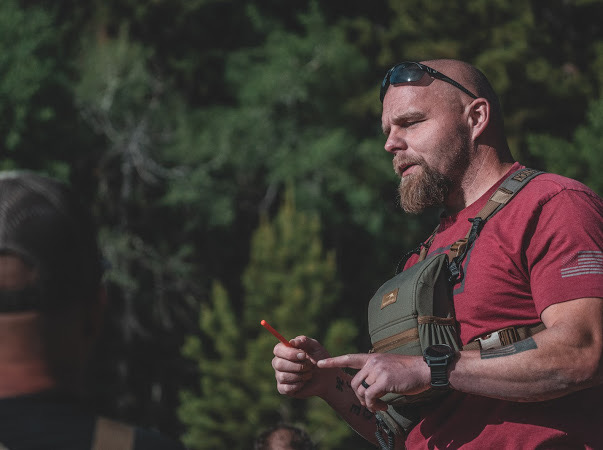
We sometimes build tents for ourselves out in the field, or sometimes I’ll get on a satellite phone and call my chief designer to explain what I need. Maybe we’ll be in Colorado at 13,000 feet, and I’ll film a weak point on what we have or something we need to change. He’ll literally draw it up and send me a photo of it, to see if that’s what I’m talking about. Then he’ll build it and have it ready for me by the time I come off the mountain to go test again.
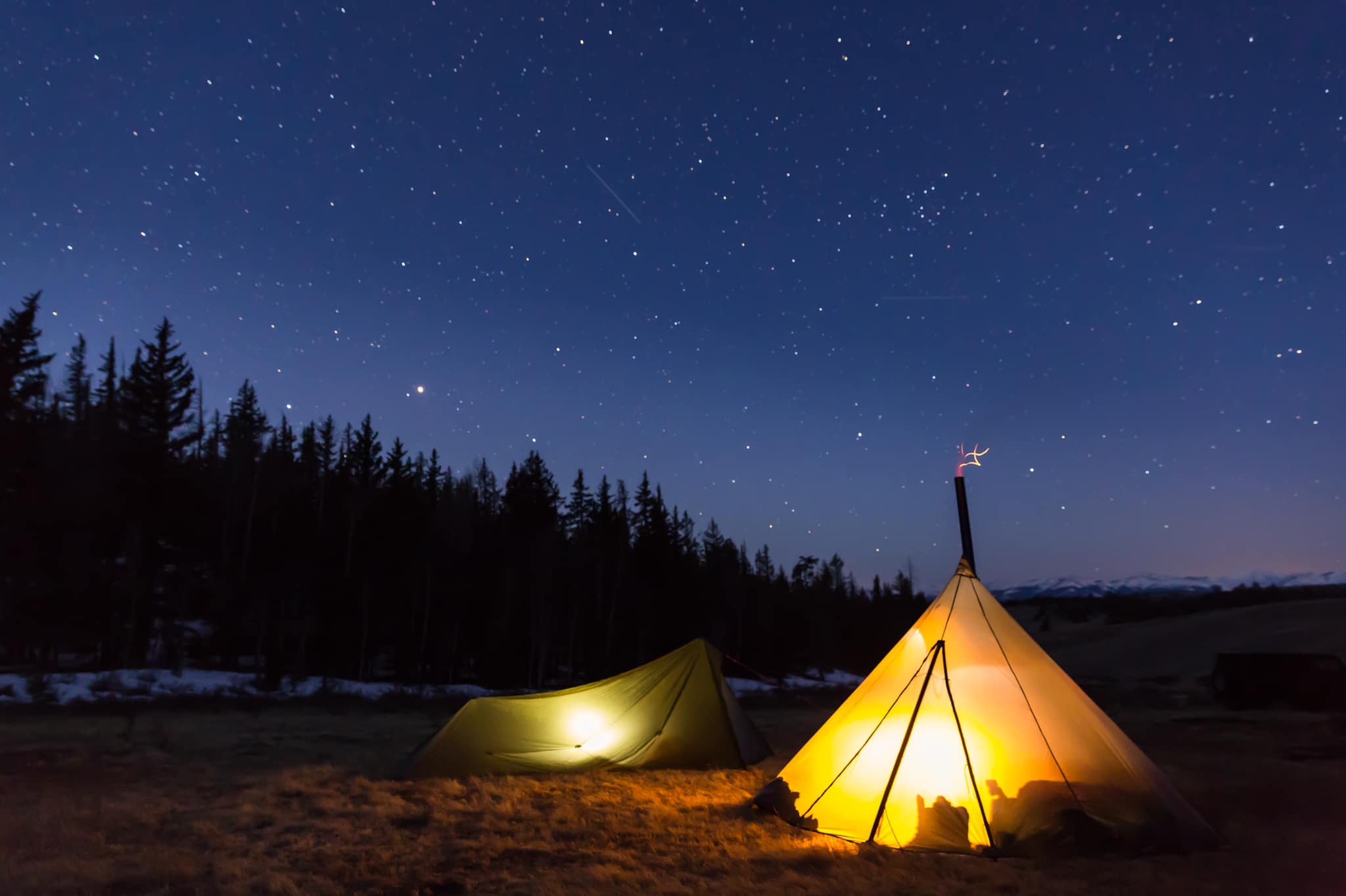
Q: How does Kifaru ensure the quality of their tents for consumers?
Snyder: The first step is that we test our raw material as soon as it comes in by cutting a yard section, filling that up with water, and hanging it up like a sleeping bag. If we leave it up for two weeks, then it’s obviously done great. The next step is an abrasion resistance test, right after we do the waterproofing, just to make sure that it meets our tenacity test standards. Once a tent is sewn together, we take one out of every ten and set it up for a wind test. We use not only a giant fan and a wind tunnel, but we also go out and set it up in a very windy area here in Colorado. A wind tunnel death can be very aggressive, but it’s still not the same as microburst wind, for example. And we obviously QC all the stitching, every tie-out point, every guyline, everything, by eye.
Q: What do you think gets overlooked in the outdoor industry?
Snyder: Having the user and the designer work hand in hand as much as they should. I see a lot of things being designed by people that maybe don’t have the practical experience, and I see a lot of people in the field that have the practical experience, but don’t have the design experience. There’s always a kind of hitch in the giddyup between the two, when that hand-in-hand close relationship between the designer in the field and the designer in the office is lacking. My chief designer is college educated, very good in the office, and good in the field, but not quite the level of experience that I have. But I don’t have a degree in engineering, so I need to have a very good relationship with the guy in the office who is making it, so that he trusts me and he can build what I need and understand it. And so that I understand the feedback he’s giving me.
Q: What is your most popular tent?
Snyder: The Sawtooth is our biggest seller.
Q: What is your personal favorite tent?
Snyder: The Supertarp would be the one I use the most.
Hilleberg
About Hilleberg
Hilleberg is based out of Frösön, Sweden, which is a similar latitude to Nome, Alaska, and has been building tents to withstand the toughest conditions on earth for over fifty years. Unlike other brands, Hilleberg only produces tents, and plans to keep doing just that for many years. I talked to Petra Hilleberg, CEO and daughter of founders Bo and Renate Hilleberg, about the brand’s history and ongoing commitment to quality and durability.
Q: How did Hilleberg first get into making tents?
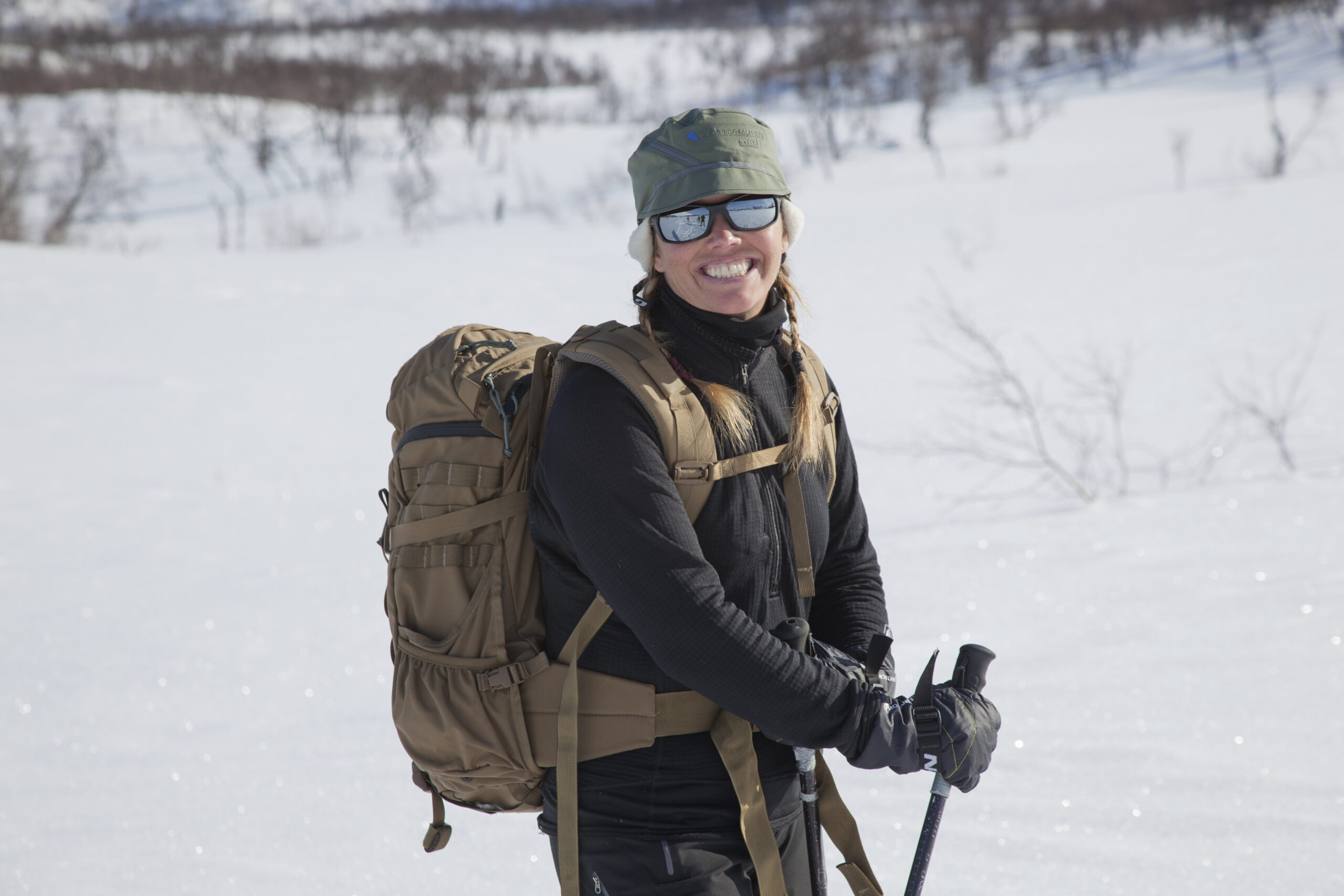
Hilleberg: My dad was outdoors a lot, working as a forester in Sweden, and he was a climber and backpacker and ski mountaineer and hunter. And he wasn’t really happy with any of the tents that were on the market. So he would make drawings, and my mom, who he met on a ski trip in Austria, figured out how to sew. She would not only build the prototypes, but she also set up a whole factory in Sweden to make them. She’s amazing. The whole idea was always to make tents that we and our best friends could use and rely on in any weather, any climate.
Tents back then were not what my dad wanted. He wanted a tent that went up all together, inner and outer tent, and we were the first to make that. He did all kinds of experimentation, including one that had a foam layer in between. But it got wet and he had to basically make a burrito out of the whole thing and sleep through that for the night. Then in the late seventies, early eighties, our first tunnel tent came out: the Keron, which is still picked for expeditions, including to the North and South Poles, even though it obviously looks different now than it did then. In the early nineties, we came out with the first one-person tent, the Akto. Back then, there was no one-person tent on the market, and people thought it was a strange concept. So that one had the most prototypes, fourteen or fifteen, before they were happy with it. That’s always been our philosophy: to make products that we stand behind completely ourselves and that we know have the highest quality. The goal was never to be a big company. It was always just to make sure that we do exactly what we want and that we know we can keep control of.
Q: How do you approach designing a new tent?

Hilleberg: We still work the same way. My mom stopped doing the prototyping about ten years ago, but Dad still heads up product development. Our problem is that we have so many different models; we always think that we’re going to remove one, but they all have their place in the line. So to design a new tent we first look both at what we have and what the need is. Then we just do a simple drawing before beginning to test. Everything we do is very physical. We use pole dummies to get an idea of the dimensions and spend a lot of time testing materials’ strengths and functions. The tear strength for most tents on the market is maybe two kilos. Our lightest fabric, our Yellow Label fabric, has eight kilos. Our Black Label fabric has eighteen kilos. You don’t need that for everyday use, but if you were to step on it with a crampon, or hit it with a broadhead, the fabric is not going to keep ripping.
The next step is to sew it and start testing the tent in our wind machine, and out in the mountains. We have a philosophy that every tent, including the big group tents, should be able to be set up by one person in the dark, wearing gloves, in a storm. So whereas some companies turn on their wind machines after the tent is set up and bolted to a cement floor, we first turn on our wind machine, which is basically a remade snow cannon, and then go in front of it to start setting up the tent. Because it doesn’t matter how strong the tent is, if you can’t set it up by yourself when conditions are really bad. That’s why our tents are not as light as others on the market, because we always have the function first. You might not need that if you go out for one or two nights, but if you’re out for weeks on end, like hunters are, where there’s so much money and time that goes into planning and preparing, the tents should not be something you have to think about. Our development process takes about two years because we want to make sure that all the details are right.
Q: How does Hilleberg ensure the quality of its tents for consumers?
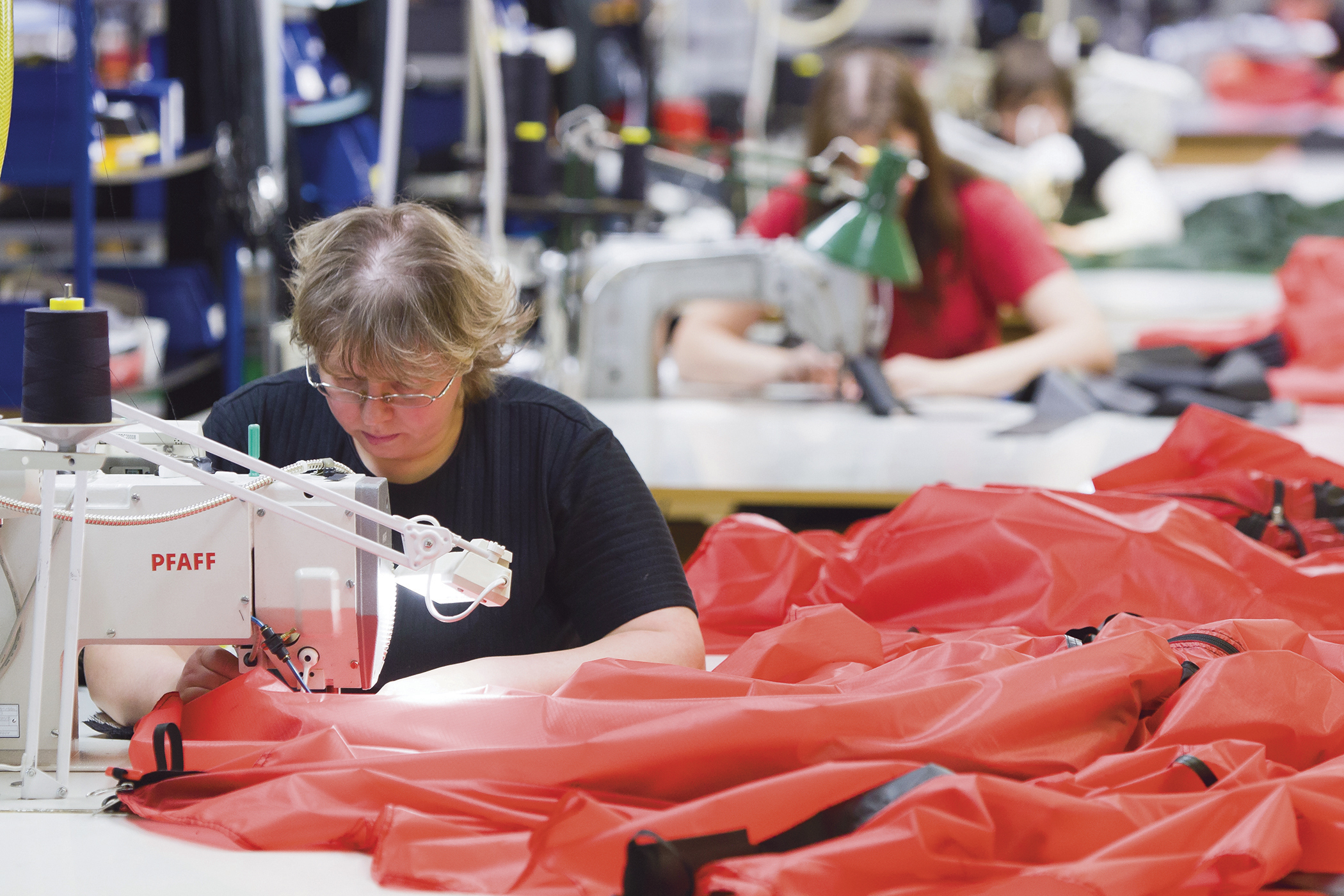
Hilleberg: There are multiple layers. First, we do hard tests with shorter spurts of really hard wind and rain using the wind machine. Next, we do long-term testing where the tent sits for hours and hours and hours with water and wind on it. Then we look at wear points, as well as guyline and peg placements. We recently scrapped one model after wind machine testing—it just was not stable enough. Then, within a few iterations, our staff will start taking a tent out for field testing in northern Sweden, in all kinds of weather. The product team will also spend a day setting up and taking down a tent, maybe six or seven times, going very short distances in between. For material testing, we work with friends or colleagues who are walking the Swedish mountain chain, called The White and Green Ribbon, which takes a couple of months. So someone will have a tent with two different kinds of floors, or two different materials in the floors, or two different panels of inner tent material.
Finally, there is our very own factory in Estonia, which we moved to twenty-five years ago and built up from the ground. Our manager and a lot of the seamstresses are still the same people that started twenty-five years ago. Each tent, each inner tent, and each outer tent, is made by one person, and they put their name tags in there, so there’s a lot of pride and responsibility for the people that make them. Then each tent is set up on a quality control table, with the poles that they will go out with and the guylines tied on, and checked by a quality control inspector.
People always ask us why we only make tents and it’s because as long as we have things that we want to develop and do with tents, then that’s what we’re focusing on. We don’t want to expand just for the sake of expansion. This is what we live and breathe and have for fifty years.
Q: What do you think gets overlooked in the outdoor industry?
Hilleberg: Well we don’t look a lot at what other people are doing. There’s a lot of focus on following fads or trends or the latest thing. If someone is going to be into ultralight then everyone is going to be ultralight, without looking at function. And the gear is often so bad. It works if you’re going on a really short trip, but it’s dangerous for some people. I also think it sets a bad precedent now with so many more people going outdoors—If you start doing something super ultralight, chances are you’re never going to do it again because you are so miserable. We’ve always talked about smart packing instead of ultralight packing: bring what you need, bring the things that make you happy, but don’t bring too much. The industry is also looking at sustainability, which is very important right now. But the most sustainable thing that you can do is make a tent that the customer never has to throw away. So we put the most sustainable and green, clean materials that we can into our processes and into our tents, but never in any way that compromises the overall quality and function of the tent. So I think that is one thing.
This is not as true for hunting, but backpacking and climbing magazines tend to only look at and talk about new things. It’s really, really unfortunate because just because it’s new doesn’t mean that it’s good. Very likely, it’s the opposite. If something has been on the market since 1980, there’s a reason it’s still there, but it will never be tested and reviewed in magazines because it’s not sexy.
Q: What’s your most popular tent?
If there is an expedition that is going to the South Pole for two months, I’ll recommend a Keron 4 GT or Keron 4. But if I have a family that is just starting out, and they want something that is comfortable and easy to use and will keep them safe, then I will recommend the same tent. But it so depends on what you need and what you want. In the one-person category, the lightweight Akto is really popular, as is the Soulo, which is roomier and more burly. The completely freestanding Allak 2 and 3 is roomy and light. The Helags is a snow-free version of the Keron, but its little brothers, the Anjan or the Nallo are popular because they are lighter. It just so depends!
Q: What’s your favorite tent, personally?
I can’t, this is like picking between my children!
FAQs
Beyond Big Agnes, NEMO Equipment, Big Agnes, Stone Glacier, and Kifaru, there are a number of excellent and innovative tent manufacturers, including Hilleburg, TarpTent, Zpacks, and Mountain Laurel Designs. We’ll be continuing this series of conversations with those brands in the coming months.
The best tent brands are dedicated to pushing the limits of what a tent can accomplish through exceptional engineering, state-of-the-art materials, and unparalleled understanding of the conditions that outdoorsmen and women can expect to face year-round.
The best tent brands tend to be significantly more expensive than budget brands—sometimes as much as six times the price. For the most intrepid outdoorsmen and women, the value of these tents is clear: if you are asking a couple of ounces of nylon and a few aluminum poles to protect you from the worst of Mother Nature, you need some of the best creative engineering the outdoor industry has to offer. If you are just getting started in the outdoors, these tents will provide the peace of mind you need to sleep soundly through the night.
Final Thoughts
Over the last two decades, the engineers, designers, and creative minds behind some of the best tent brands have pushed the industry to places never imagined. And from talking to the next generation of leaders it’s clear that they’ll be looking to build on these innovations, with products that are lighter and stronger, designed for use in an ever wider range of environments and applications, in the coming years.
